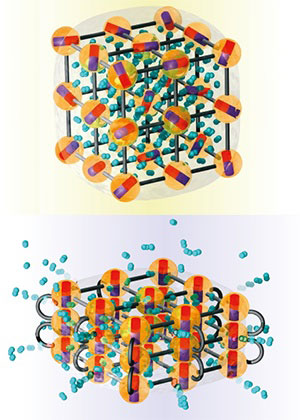| Oct 03, 2011 |
Magnetic sponge
|
|
(Nanowerk News) Flexible networks consisting of magnetic metal centers have previously been shown to expand and contract on the absorption and desorption of guest molecules such as water or nitrogen gas. Now, in an intriguing step forward in the development of these magnetic 'sponge' materials, Toshiaki Enoki, Yoshikazu Ito and colleagues from the Tokyo Institute of Technology in Japan, together with collaborators in other institutes in Japan and the National University of Singapore, have developed a nanoporous material that can reversibly absorb and desorb guest molecules with changes in magnetic field ("Magnetic sponge prepared with an alkanedithiol-bridged network of nanomagnets").
|
|
The magnetic sponge developed by Enoki and his colleagues incorporates cobalt-palladium (Co-Pd) alloy nanoparticles at the joints in the framework with long-alkyl-chain molecules as the flexible linking component. The network naturally forms an expanded nanoporous structure that soaks up guest molecules. When a magnetic field is applied, however, the network contracts and expels the guest molecules (see image).
|
 |
| Schematic illustration of the expanded (top) and contracted (bottom) states of the magnetic sponge. (© 2011 ACS)
|
|
This morphological change is caused by the rotation of the magnetic nanoparticles to align parallel with the magnetic field, reducing the interparticle distance parallel to the field but increasing it in the perpendicular direction. At extremely low temperatures, this anisotropic stretching causes the magnetization of the material to increase by 500%. "Industrially, it is a fascinating discovery that the morphology can be switched using magnetic fields," says Enoki. "By switching the magnetic field on and off, the magnetic sponge can release or catch molecules whenever and wherever needed. This simple system has practical potential in drug delivery systems or in catalytic reactions."
|
|
The magnetic sponge developed by Enoki and his colleagues achieves its highest performance at low temperatures approaching absolute zero and under strong magnetic fields of up to 7 T, and so its scope for application is at present quite limited. Future studies will focus on developing magnetic sponges with a high volume-change response at room temperature. The researchers also intend to introduce functional groups into the flexible linkers with the aim of adding not only hydrophobic and hydrophilic functions but also catalytic and sensor functions. The next generation of magnetic sponges could therefore incorporate more complex functionality driven by changes in an externally applied magnetic field.
|

